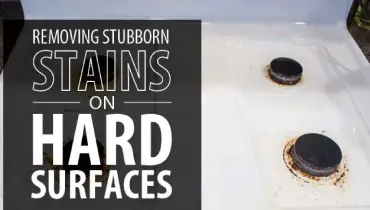
Rainbow Restoration offers expert guidance on removing stubborn stains from hard surfaces. Key tips include:
|
Removing stubborn stains from hard surfaces can be trickier than tackling more common surfaces that attract stains, such as your couch. If you have a stained sink, countertop, or tile floor, follow these stain removal tips.
How to Remove Stains from Kitchen & Bathroom Sinks
Ceramic and porcelain sinks readily attract stains. Here’s how to remove them.
How to Remove Hair Dye from a Bathroom Sink
- Place a denture cleaning tablet on a plate and crush it into a fine powder.
- Add a few drops of water until it forms a paste.
- Dip a dry, clean washcloth into the paste. Apply it to the stain using small circular motions.
- Let the paste sit for 10 to 15 minutes.
- Wet a cloth with hot water and scrub the area to remove the paste and the stain.
- Repeat if necessary.
How to Remove Hard Water and Soap Residue from a Porcelain Kitchen Sink
- Mix equal parts cream of tartar and vinegar or equal parts cream of tartar and hydrogen peroxide. A commercial product called Bar Keepers Friend also works well.
- Apply your cleaning product of choice to a sponge or cloth and scrub the sink in small circular motions.
- Allow the cleaner to sit for a few minutes to maximize its cleaning power.
- Rinse the sink to remove cleaning residue.
How to Remove Stains from Kitchen & Bathroom Countertops
From juice and coffee to mold and rust, you can make your own stain remover to clean kitchen and bathroom countertops.
Laminate countertops
- Remove fruit juice stains with a baking soda and water paste. Because baking soda is slightly abrasive, don’t scrub. Instead, apply the paste, let it sit for one to two hours, and then gently wipe it off.
- Remove ink stains with nail polish remover. Apply it with a white rag to avoid transferring color to the countertop.
Granite, marble, and other stone countertops
You can remove just about any stain from stone countertops by forming a paste with absorbent flour or dry clay and a wicking chemical agent.
- For food stains, mix flour with hydrogen peroxide.
- For oily or greasy stains, mix flour with dishwashing soap.
- For mold, mildew, or fungus, mix flour with chlorine bleach.
- For rust stains, mix flour with sodium hydrosulfate.
Once you make the appropriate paste, follow these stain remover tips:
- Apply a thick layer of paste to the stained area.
- Cover the paste with a sheet of plastic taped down on all sides. Let the paste sit for 12 to 24 hours. The longer it sits, the better it works.
- Remove the plastic and scrape the dried paste away with a putty knife. Repeat if any stain remains.
- Polish the countertop to create a smooth, uniform surface where the stain was.
- Seal the surface to reduce future staining.
How to Remove Stains from Tiled Floors
Use the appropriate stain remover to lift specific types of stains:
- To remove blood stains, dab with hydrogen peroxide or bleach diluted with water.
- To remove coffee or juice stains, wash the area with hot water and soap. Then, blot with hydrogen peroxide or diluted bleach.
- To remove grease stains, wash with club soda and water.
Schedule Professional Stain Removal
If your DIY attempts at removing stubborn stains on hard surfaces prove fruitless, let Rainbow Restoration ® lend a hand. We offer tile, grout, and hard surface cleaning to help your home look and smell like new again. Whether you want your bathroom sinks shined, kitchen counters cleaned, or tile floors restored, we’ve got you covered! Contact us today to learn more about our services or to schedule an appointment.
To help meet all of your home service needs, check out Neighborly. Once on the site, click on "Join the Community" to find providers to service all your home needs.
